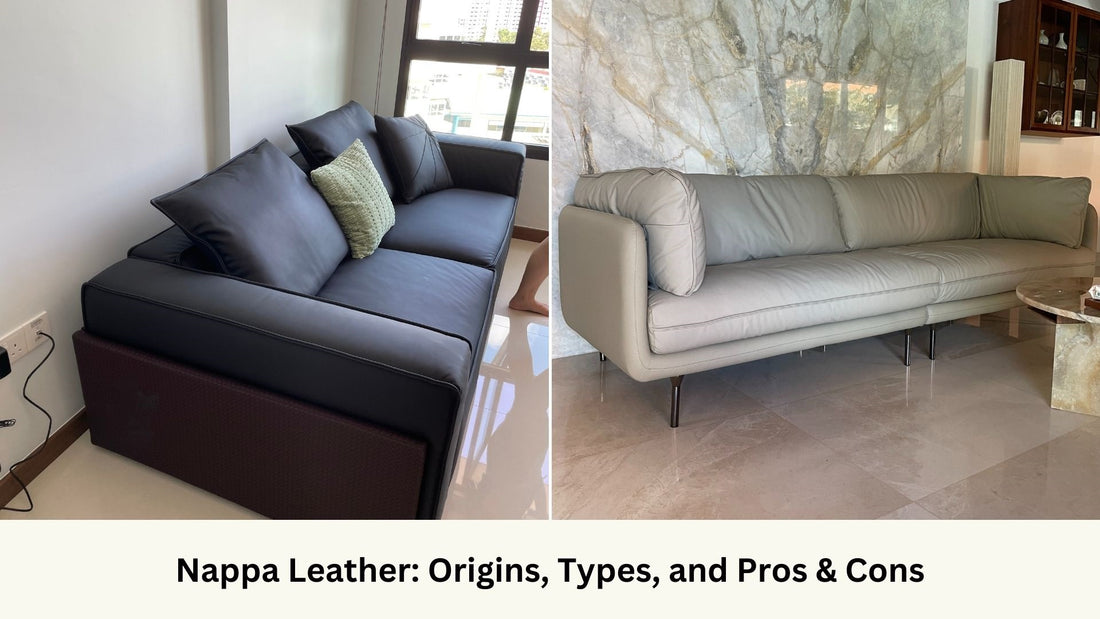
Nappa Leather: Origins, Types, and Pros & Cons
Share
What is Nappa Leather Known For?
Nappa leather is renowned for its softness, smooth texture, and luxurious feel. It is often used in high-end products like car interiors, furniture, and fashion accessories, where comfort and quality are essential. Its fine grain and supple touch set it apart from other types of leather, making it a popular choice for premium goods.
Origins of Nappa Leather
Nappa leather was first introduced in 1875 by Emanuel Manasse, a German tanner working at the Sawyer Tanning Company in Napa, California. The name “Nappa” comes from the region of its origin. Originally, Nappa leather was crafted from lamb, kid, or sheep skin. Over time, its production evolved, and today, Nappa leather is also made from cow and calf hides.
How Nappa Leather Is Made
1. Selection of Hide
Nappa leather is made from selective hides, typically sourced from animals such as lamb, sheep, and cows. The key requirement is that the skin must be fine and soft, ensuring the high quality needed to produce Nappa leather.
2. Pre-Treatment
The hides are pre-treated to remove dirt, hair, and other impurities. At this stage, the amount of treatment—such as sanding or buffing—determines whether the leather will be classified as full-grain, top-grain, or corrected-grain Nappa leather.
3. Tanning
Nappa leather undergoes chrome tanning, a process that helps make the leather soft and supple while enhancing its durability.
4. Softening
After tanning, mechanical processes like rolling and stretching are applied to further soften the leather, giving Nappa its characteristic softness and flexibility.
5. Finishing
In the final stage, water-soluble dyes or pigmented embossing are used to add color and provide the leather with a consistent finish. This also helps protect the leather while maintaining its luxurious appearance.
Types of Nappa Leather Based on Treatment and Finishing
-
Full-Grain Nappa Leather: This is the highest quality of Nappa leather, made from the top layer of the hide. It retains the natural grain, making it soft, durable, and breathable.
-
Aniline Nappa Leather: Aniline Nappa leather is dyed with soluble dyes without surface treatment or pigment coating, preserving the hide's natural look but making it more vulnerable to wear.
-
Semi-Aniline Nappa Leather: Semi-aniline Nappa leather is treated with a light surface coating to provide some protection while still maintaining the leather’s natural feel.
-
Top-Grain Nappa Leather: Light sanding or buffing removes imperfections while retaining much of Nappa’s softness. It has a more uniform appearance and is durable but less breathable.
-
Corrected-Grain Nappa Leather: This leather undergoes significant treatment, including sanding and embossing, for a smooth, consistent finish, though it loses some softness.
-
Nubuck Nappa Leather: Nubuck Nappa is created by sanding the hide's outer surface to produce a velvety texture. While soft, it’s more prone to staining and scuffs.
Main Differences Between Nappa Leather and Other Leathers
The primary difference between Nappa leather and other types of leather is its softness and minimal processing. Nappa leather is generally more flexible and thinner compared to other types, which makes it ideal for luxury products like high-end furniture, car interiors, and fashion accessories.
Pros and Cons of Nappa Leather
Pros:
-
Softness and Comfort: Nappa leather is known for its exceptional softness, making it ideal for items in direct contact with skin, such as gloves and jackets.
-
Durability: Despite its soft feel, Nappa leather is highly durable, especially full-grain varieties.
-
Natural Appearance: Nappa leather retains much of the hide’s natural beauty, including unique markings and textures.
-
Breathability: The natural pores in Nappa leather allow air to pass through, providing excellent breathability.
Cons:
-
Maintenance: Nappa leather, particularly aniline varieties, requires regular care to prevent stains and wear.
-
Cost: As a premium leather, Nappa comes with a higher price tag.
-
Susceptibility to Damage: Nappa leather is more prone to scratches and stains due to minimal treatment.
-
Limited Color Range: Nappa leather often comes in natural, muted shades compared to heavily processed leathers.
Conclusion
Nappa leather is a luxurious material that stands out for its softness, flexibility, and natural beauty. While it requires more maintenance and comes at a higher cost, its comfort and elegance make it an excellent choice for those who prioritize quality and style in their leather goods.
Published: 21st Oct 2024
